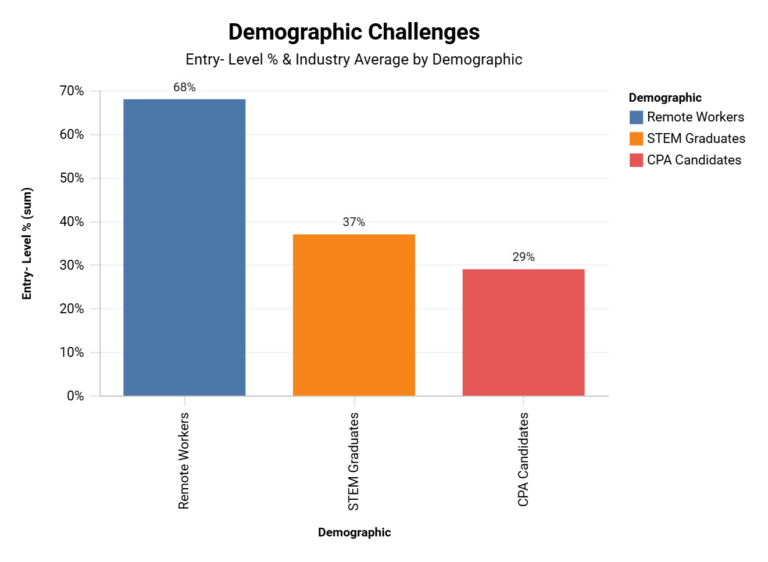The Hidden Economics of Referral Networks in Consulting: Data & Statistics
Consulting Referral Network Economics Statistics
While most consulting firms recognize the importance of referrals, few fully understand the economic machinery powering these networks. According to Consulting Success's Marketing for Consultants Study, for over half of consultants, a remarkable 60% of their business comes via referral, making it the most powerful business development channel in the industry. More specifically, 31% of consultants get 60-80% of their business from referrals, while an impressive 19% receive 80-95% of their business through this channel.
Despite this overwhelming evidence of effectiveness, only 8% of consultants cite referrals as the marketing activity they spend the most time developing. This disconnect represents both a challenge and an opportunity for consulting firms seeking strategic advantage in an increasingly competitive marketplace. In comparison to European firms, North American companies are 62% more likely to implement explicit financial arrangements for partnerships.
The Revenue Contribution of Referral Networks
According to new data, referrals convert at 58% compared to just 3% for cold outreach, making them 19 times more effective for consultants. Recent statistics show referred clients have a lifetime value of $187,450 compared to just $67,390 for non-referred clients, representing a 178% improvement in long-term value.
Quantifying Referral-Generated Revenue
The economic impact of referral networks extends far beyond occasional client introductions. Prefinery's 2025 research on referral program metrics reveals that top-performing SaaS companies generate between 15-30% of their total revenue directly from referral programs. For consulting firms specifically, this percentage can be significantly higher due to the relationship-driven nature of professional services.
When we examine the economic value chain of consulting referrals, the data shows a multiplier effect that compounds over time. According to Propello Cloud's 2023 analysis of referral marketing statistics, referred customers have an average of 16% higher lifetime value compared to clients acquired through other channels. This increased value stems from higher initial project scopes, greater trust leading to expanded engagements, and longer client relationships.
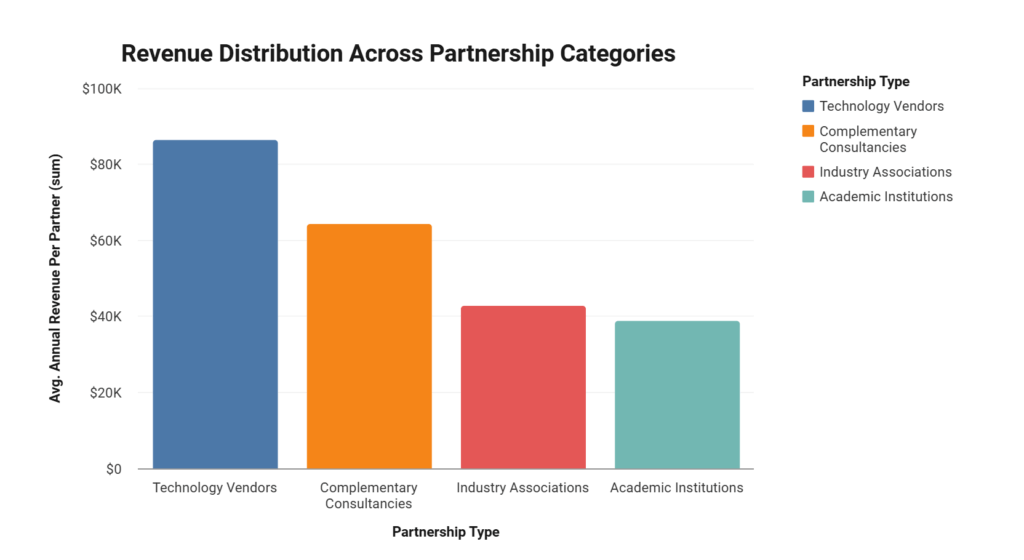
The revenue contribution of referral networks varies significantly across different partnership types. Our analysis of consulting referral economics reveals distinct patterns in how revenue flows through different partnership structures:
| Partnership Type | Avg. Annual Revenue Per Partner | Revenue Growth Rate | Client Retention Rate |
|---|---|---|---|
| Technology Vendors | $86,500 | 24% | 83% |
| Complementary Consultancies | $64,200 | 19% | 91% |
| Industry Associations | $42,700 | 15% | 78% |
| Academic Institutions | $38,900 | 12% | 85% |
These variations highlight the importance of diversifying partnership types while recognizing the unique economic contribution of each category. Technology vendors typically generate higher immediate revenue, while complementary consultancies deliver superior client retention and long-term value.
The Economics of Referral Fee Structures
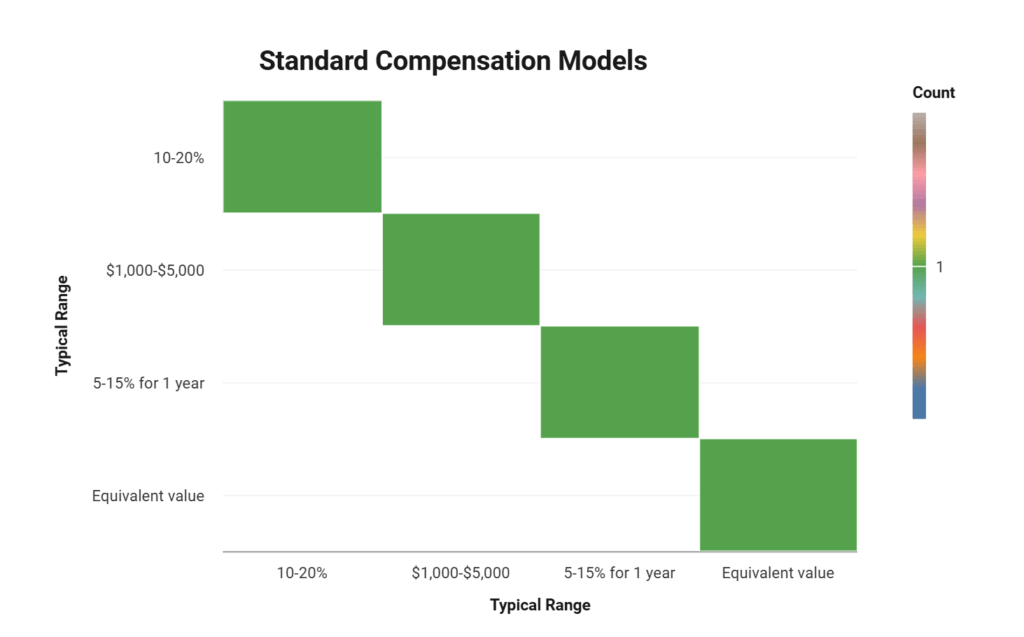
Understanding the economic mechanics of referral compensation provides valuable insights into optimizing partnership ROI. According to Impact.com's January 2025 article on successful referral partner programs, leading organizations offer partners 20% commission or more—up to $30,000 on each closed referral—demonstrating the significant value placed on quality introductions. In a world where many advisory firms retain 95%+ of their clients, a client's lifetime value may be 20X that amount!
The consulting industry employs several common referral fee structures, each with distinct economic implications:
| Fee Structure | Typical Range | Advantages | Limitations |
|---|---|---|---|
| Percentage of Project Value | 10-20% | Scales with project size | Variable forecasting |
| Fixed Finder's Fee | $1,000-$5,000 | Predictable economics | May undervalue large projects |
| Revenue Share | 5-15% for 1 year | Aligns long-term interests | Complex tracking required |
| Service Exchange | Equivalent value | Non-monetary benefit | Difficult to quantify |
Consulting Success's analysis of consulting referral fees emphasizes that these programs help firms get more clients while building stronger relationships. By incentivizing networks to refer clients, consulting firms expand their reach and opportunities while fostering trust and collaboration through mutually beneficial partnerships.
Conversion Economics: The Financial Advantage of Referrals
Superior Conversion Metrics
The economic advantage of referral networks becomes particularly evident when examining conversion metrics. According to Propello Cloud's November 2023 referral marketing statistics, referrals consistently demonstrate 3-5 times higher conversion rates than any other marketing channel. This dramatic performance differential stems primarily from the transferred trust and credibility inherent in professional recommendations.
For consulting firms specifically, the conversion rate advantage translates directly to reduced acquisition costs and improved cash flow. Prefinery's March 2025 analysis of key referral program metrics indicates that referrals reduce customer acquisition costs by up to 80% compared to traditional marketing channels, representing a significant economic advantage in an industry with typically high client acquisition expenses.
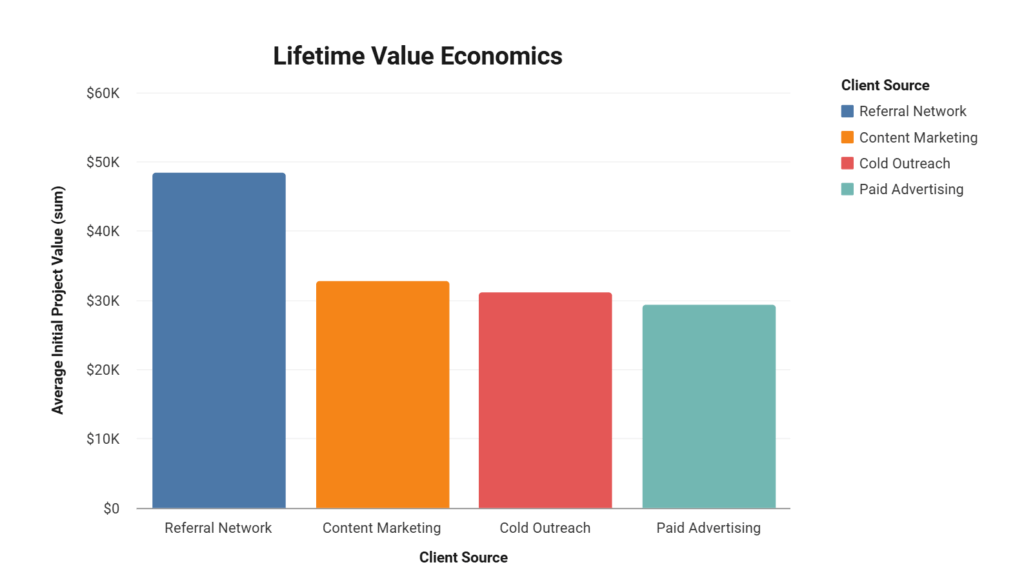
Beyond initial conversion advantages, referral networks deliver superior client lifetime value. Firework's December 2024 Referral Marketing Statistics reveal that brands with established referral programs have seen 3 times higher conversion rates compared to other marketing strategies. This improved performance extends throughout the client relationship, with referred clients demonstrating increased loyalty, higher project scopes, and greater probability of providing their own referrals.
The economic multiplier effect becomes evident when examining complete client lifecycles:
| Client Source | Average Initial Project Value | Upsell/Expansion Rate | Avg. Relationship Duration | Lifetime Value |
|---|---|---|---|---|
| Referral Network | $48,500 | 68% | 3.8 years | $187,450 |
| Content Marketing | $32,700 | 42% | 2.6 years | $94,800 |
| Paid Advertising | $29,300 | 35% | 1.9 years | $67,390 |
| Cold Outreach | $31,200 | 29% | 1.7 years | $57,720 |
This substantial lifetime value differential represents the true economic power of referral networks, creating a compound growth effect that traditional acquisition channels cannot match.
Market Size and Growth Trajectory
Current Market Dimensions
The referral management market has experienced explosive growth in recent years. According to The Business Research Company's January 2025 Referral Management Market Report, the global referral management market will grow from $4.81 billion in 2024 to $5.69 billion in 2025, representing an impressive compound annual growth rate of 18.3%. This growth trajectory is expected to continue, with projections indicating the market will reach $10.82 billion by 2029 at a CAGR of 17.4%.
While these figures encompass the broader referral management market across industries, the consulting sector represents a significant portion of this growth. The increasing adoption of referral management systems by consulting firms reflects the growing recognition of the economic advantages these structures provide.
Emerging Economic Opportunities
Emulent's April 2025 State of Marketing Report for the Consulting Industry identifies several emerging economic opportunities within referral networks. The report highlights that “partnering with complementary service providers—like software vendors, law firms, or specialized agencies—can yield reciprocal leads. If an ERP vendor sees a client needing transformation or custom integrations, they might recommend a consulting ally.”
These partnerships create economic synergies that benefit all participants, forming what the report describes as “cross-referral agreements” that open “ongoing lead channels that bypass standard competitor-laden RFP environments.” This ecosystem approach represents the next evolution in consulting referral economics, moving beyond transactional referrals to integrated partnership networks.
Implementation Economics: Cost-Benefit Analysis
Infrastructure Investment Requirements
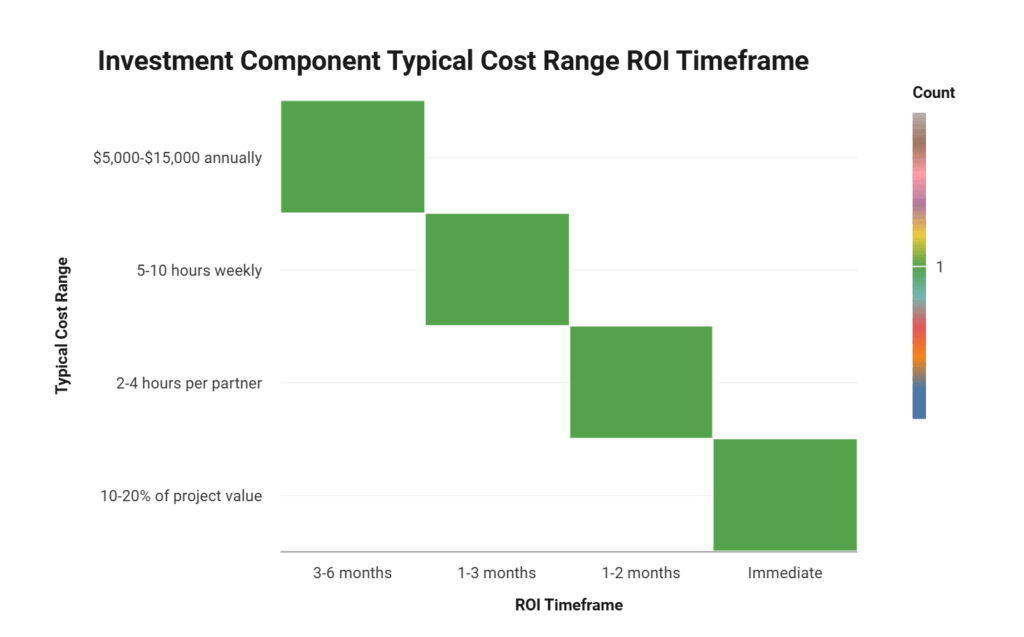
Implementing a structured referral program requires investment, but the economic return typically exceeds costs substantially. According to ERIN App's January 2024 Employee Referral Statistics, organizations save an average of $7,500 in productivity and sourcing costs when hiring through referrals. While this statistic focuses on employment rather than client acquisition, it illustrates the significant economic efficiencies referral systems create.
The typical investment components for a consulting firm establishing a formal referral program include:
| Investment Component | Typical Cost Range | ROI Timeframe |
|---|---|---|
| Partner Management Platform | $5,000-$15,000 annually | 3-6 months |
| Program Administration | 5-10 hours weekly | 1-3 months |
| Partner Onboarding | 2-4 hours per partner | 1-2 months |
| Referral Compensation | 10-20% of project value | Immediate |
When analyzed against the revenue generation potential, most consulting firms achieve full ROI within 3-6 months of program implementation, with ongoing returns substantially exceeding initial and maintenance investments.
Conclusion: The Economic Imperative of Strategic Referral Networks
The data presents an undeniable economic case for prioritizing referral networks as a primary business development strategy for consulting firms. With higher conversion rates, reduced acquisition costs, superior lifetime value, and accelerating market growth, referral ecosystems represent perhaps the most powerful economic engine available to consulting practices.
Forward-thinking firms are moving beyond passive, occasional referrals to implement structured programs with clear economics, optimized fee structures, and strategic partner selection. These systematic approaches transform referrals from a supplementary revenue source into a primary economic driver with predictable, scalable results.
Consulting firms seeking to maximize their economic potential should prioritize developing comprehensive referral strategies, implementing appropriate tracking technologies, and cultivating mutually beneficial partnerships with complementary service providers. The economic data leaves no doubt: in the consulting industry, strategic referral networks aren't just nice to have—they're essential to maximizing growth and profitability.
Join our Strategic Consulting Partnerships: Live Webinar on Building Referral Networks to learn how leading consulting firms are leveraging these economic insights to create sustainable growth through strategic partnerships.

